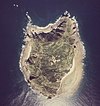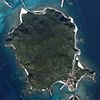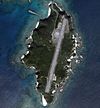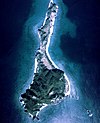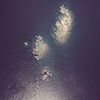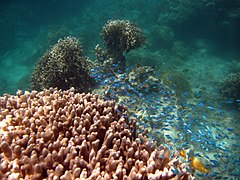| Native name: Kerama-shotō (慶良間諸島) | |
|---|---|
 | |
 Map of the Kerama Islands Map of the Kerama Islands | |
    | |
| Geography | |
| Location | Pacific Ocean |
| Coordinates | 26°12′00″N 127°19′59″E / 26.2°N 127.333°E / 26.2; 127.333 |
| Archipelago | Okinawa Islands |
| Total islands | 36 |
| Major islands | Tokashiki Island, Zamami Island |
| Area | 35.97 km (13.89 sq mi) |
| Administration | |
| Japan | |
| Prefecture | Okinawa Prefecture |
| Demographics | |
| Population | 1,625 (October 2010) |
| Pop. density | 45.2/km (117.1/sq mi) |
| Ethnic groups | Ryukyuan, Japanese |
| Ramsar Wetland | |
| Official name | Keramashoto Coral Reef |
| Designated | 8 November 2005 |
| Reference no. | 1546 |
The Kerama Islands (慶良間諸島, Kerama-shotō, Okinawan: キラマ Kirama) are a subtropical island group 32 kilometres (20 mi) southwest of Okinawa Island in Japan.
Geography
Four islands are inhabited: Tokashiki Island, Zamami Island, Aka Island, and Geruma Island. The islands are administered as Tokashiki Village and Zamami Village within Shimajiri District. The Kerama-shotō coral reef is a Ramsar Site.
The archipelago consists of the following islands (-jima/-shima) – inhabited ones are highlighted in blue – and rocks (other suffixes, unnamed entries) with an area of at least 0.01 km.
Beaches
These are notable beaches of the Kerama Islands:
| Name | Island | Japanese name |
|---|---|---|
| Aharen Beach | Tokashiki Island | 阿波連ビーチ(渡嘉敷島) |
| Tokashiku Beach | Tokashiki Island | 渡嘉志久ビーチ(渡嘉敷島) |
| Ama Beach | Zamami Island | 阿真ビーチ(座間味島) |
| Furuzamami Beach | Zamami Island | 古座間味ビーチ(座間味島) |
| Kitahama Beach | Aka Island | 北浜ビーチ(阿嘉島) |
-
 Ama beach in Zamami island
Ama beach in Zamami island
-
Aharen Beach on Tokashiki Island
-
Tokashiku beach on Tokashiki Island
-
 Tokashiku beach
Tokashiku beach
Flora
The archipelago has several extensive coral reefs. Two of them were designated as Ramsar sites in November 2005: a 120-hectare area along the west coast of Tokashiki-jima and around Hanari-jima, and a 233-hectare area around Ijakaja-jima, Gahi-jima and Agenashiku-jima , i.e., between Aka Island and Zamami Island. These reefs are home to 248 different coral species, most notably of the Acropora genus. On March 5, 2014, the waters and the islands were placed under protection as Kerama Shotō National Park.
Fauna
The islands of Aka, Fukaji, Geruma and Yakabi provide the sole natural habitat of the endangered Kerama deer (Cervus nippon keramae), thought to be an introduced population of the Japanese sika deer in the early 17th century that has since adapted to their island environment.
History
The Kerama islands were historically part of the Ryukyu Kingdom (1429–1879), when islanders were employed as navigators on the kingdom’s trading vessels to China.
During World War II and preliminary to the Battle of Okinawa, soldiers of the 77th Infantry Division landed in the Kerama Islands on March 26, 1945. Further landings followed, and the Kerama group was secured over the next five days. Kerama was used as a staging area for the assault on Okinawa. During the battle the first civilian mass suicides that later marked the Battle of Okinawa took place. The first US Navy ship to anchor in the harbor was USS Makin Island, a small "jeep" carrier.
Thereafter, the archipelago, like the rest of the Ryukyu Islands, was under US military administration before being returned to Japan in 1972.
The Kerama islands was the site of a true story about romance between two dogs who lived on neighboring islands that was made into the 1988 Japanese film I Want to See Marilyn (Marilyn ni Aitai). It is now a popular beach and diving destination for visitors to Okinawa.
-
 The 77th Infantry Division on Zamami Island during World War II
The 77th Infantry Division on Zamami Island during World War II
Transportation
The Kerama Islands are served by the Kerama Airport, located on Fukaji Island. Regular ferries are also available from Naha to the three largest islands, Aka, Zamami, and Tokashiki. Ferries between the islands are also available, as are boat tours.
References
- "Keramashoto Coral Reef". Ramsar Sites Information Service. Retrieved 25 April 2018.
- Kerama Islands. Open Coast Travel.
- Special Feature #1 : Seas of Okinawa -The Kerama Islands- Archived 2011-05-17 at the Wayback Machine, Okinawa Prefecture
- "Ramsar Sites in Japan - Kerama-shoto Coral Reef" (PDF). Ministry of the Environment. Retrieved 24 March 2011.
- "沖縄県島しょ別面積一覧" (in Japanese). Präfektur Okinawa. 2013-11-13. Archived from the original on 2020-04-17.
- "指定離島・指定離島一覧" (PDF). pref.okinawa.jp 離島関係資料(平成28年1月) (in Japanese). 沖縄県企画部地域・離島課 . 2016-01-01. Retrieved 2016-08-03.
- vermutete Zuordnung: In der Quelle als シマ(砂白島北) ‚Insel (nördlich von Sunashiru-jima)‘ aufgeführt. Auf den amtlichen Karten ist an diesen Koordinaten eine unbenannte Insel mit der angegebenen Fläche.
- vermutete Zuordnung: In der Quelle als シマ(モカラク島北) ‚Insel (nördlich von Mokaraku-jima)‘ aufgeführt. Auf den amtlichen Karten ist an diesen Koordinaten eine unbenannte Insel mit der angegebenen Fläche.
- "Kerama-shoto Coral Reef" (PDF; 523 kB). Conservation and Wise Use of Rich and Diverse Wetlands: Ramsar Sites in Japan. Ministry of the Environment. 2008. p. 41. Retrieved 2012-11-29.
- "Cervus nippon keramae". National Institute for Environmental Studies. Retrieved 2014-06-11.
- "Kerama islands". Kerama islands. Retrieved 2016-06-10.
- Marilyn Ni Aitai at IMDb

- Map showing islands of Zamami Village Archived 2011-05-26 at the Wayback Machine




